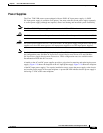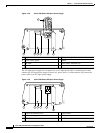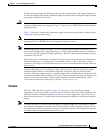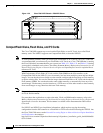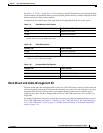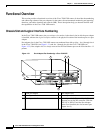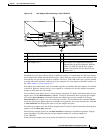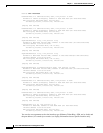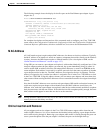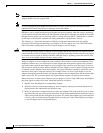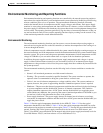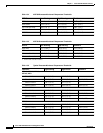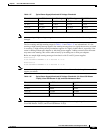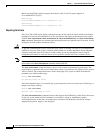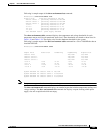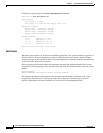
1-59
Cisco 7200 VXR Installation and Configuration Guide
OL-5013-08
Chapter 1 Cisco 7200 VXR Product Overview
Functional Overview
Environmental Monitoring and Reporting Functions
Environmental monitoring and reporting functions are controlled by the network processing engine or
network services engine and allow you tomaintain normalsystem operation by identifying andresolving
adverse conditions prior to loss of operation. The environmental monitoring functions constantly
monitor the internal chassis air temperature and DC supply voltages and currents. Each power supply
monitors its own voltage and temperature and shuts itself down if it detects a critical condition within
the power supply. If conditions reach shutdown, the system shuts down to avoid equipment damage from
excessive heat. The reporting functions periodically log the values of measured parameters so that you
can retrieve them for analysis later, and the reporting functions display warnings on the console if any
of the monitored parameters exceed defined thresholds.
Environmental Monitoring
The environmental monitoring functions use four sensors, two on the network processing engine or
network services engine and two on the I/O controller, to monitor the temperature of the cooling air as
it moves through the chassis.
If the air temperature exceeds a defined threshold, the system controller displays warning messages on
the console terminal, and if the temperature exceeds the shutdown threshold, the system controller shuts
down the system. The system stores the present parameter measurements for both temperature and DC
voltage in NVRAM so you can retrieve them later as a report of the last shutdown parameters.
In addition, the power supplies monitor internal power supply temperatures and voltages. A power
supply is either within tolerance (normal) or out of tolerance (critical). If an internal power supply
temperature or voltage reaches a critical level, the power supply shuts down without any interaction with
the system processor.
The environmental monitoring functions use the following levels of status conditions to monitor the
system:
• Normal—All monitored parameters are within normal tolerances.
• Warning—The system has exceeded a specified threshold. The system continues to operate, but
operator action is recommended to bring the system back to a normal state.
• Critical—An out-of-tolerance temperature or voltage condition exists. The system continues to
operate; however, the system is approaching shutdown. Immediate operator action is required.
• Shutdown—The processor hasdetected atemperature condition thatcould resultin physicaldamage
to system components and has disabled DC power to all internal components. This condition
requires immediate operator action. All DC power remains disabled until you toggle the power
switch. Before any shutdown, the system logs the status of monitored parameters in NVRAM so you
can retrieve it later to help determine the cause of the problem.
• Power supply shutdown—The power supply detected an internal out-of-tolerance overvoltage,
overcurrent, or temperature condition and shutitself down. All DC power remains disabled untilyou
toggle the power switch.
Table 1-34 lists the typical temperature thresholds for the NPE-G2. Table 1-35 lists the typical
temperature thresholds for the NPE-G1. Table 1-36 lists the typical temperature thresholds for earlier
network processing engines or network services engine, Table 1-37 lists the DC power thresholds for the
normal, warning, and critical (power supply-monitored) levels for most Cisco IOS releases, and
Table1-3 lists the DC power thresholds for the normal and critical (power supply-monitored) levels for
Cisco IOS Release 12.0(23) and later releases of Cisco IOS Release 12.0.



